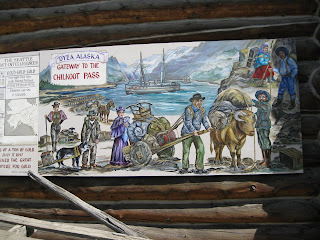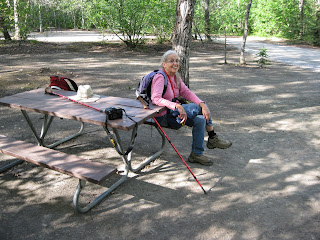When we stopped and camped in Dyea, (pronounced dye-EE) I finally started getting a grasp of the craziness of the gold rush era. Gold was first discovered in California in 1849. Then the shout went out from Alaska. That started the Klondike gold rush of 1897-1898 and captured the imagination of the world. People from all over travelled to Alaska and scrambled however they could to be one of the lucky ones to get there fast and stake their claim. The Park Rangers at Dyea told us that less than 1% of the miners struck it rich. The people who profitted were those who sold the supplies and services to the miners.
A mural in Whitehorse
The Chilkoot Trail was the shortest and the best known route to the Klondike. There is a photograph of an endless line of stampeders struggling over the Chilkoot Pass in the dead of winter in 1897-98. That image represents the powerful drive of the dream of finding gold and getting rich. Some prospectors travelled up the Fraser Valley, others took ships right into the Taiya Inlet at Skaway and from there they hiked the Chilkoot Pass over to Lake Bennett and routes north.
A mural from the MacBride Museum in Whitehorse
In 1897 Dyea, the small settlement of native packers and a trading post, suddenly became a city. It was the gateway to the Chilkoot Pass that gave prospectors a shortcut to the Klondike gold fields. Tents and shacks, outfitting stores, restaurants, hotels and saloons crowded the river plain. At one point over 150 businesses offered services to the stampeders. By the spring of 1898 Dyea's population had swelled to a transient population of as many as 10,000. Dyea made the national headlines!
Common Horsetails
Now it is hard to even imagine there ever was a town here, along the tidal flats of Taiya Inlet. From the road driving into the campsite we could see a few rows of rotting wharf pilings. There is a small graveyard called "Slide Cemetery" which holds the bodies of 70 men killed in a snow avalanche on the Chilkoot Pass, and there are a few remains of buildings and depressions in the ground that indicate where the town once stood. One of the kiosks along the walking tour notes the "Dyea's growth and demise was abrupt as the gold rush itself. When the White Pass and Yukon Route Railway opened in 1898, that linked Skagway and Lake Bennett, Dyea began to fade. Most of the buildings were torn down and the lumber was hauled away."
Today only the trail over Chilkoot Pass remains basically as it was. I was touched by the vibrant history of Dyea, and could almost feel the frantic energy of the gold rush days. David and I decided to hike the first part of the trail just to experience how it may have felt. Of course we were doing it on a sunny day in June and not in the middle of winter, but we still got to walk the trail and let our imaginations fly.
The trail is very steep at the beginning. This section is known as "Saintly Hill" because anyone who can climb it without swearing would be considered a saint.
After the initial part, the trail got easier, and sometimes almost felt like a walk in the park.
There was one long section of boardwalk that crossed many beaver ponds.
After that we began seeing bits of trash along the trail that were left behind by the prospectors. I couldn't help but wonder how the men made the climb in the middle of the winter. By law the would-be-miners had to carry in one ton of supplies to prevent their starvation once they got to the Yukon. That meant that they had to hike the Chilkoot Pass up to twenty times before they could push on.
David and I put in a long day of hiking and never even reached the first established camp at Finnigan's Landing. However, we had great fun. And, you can bet I was one happy camper to finally get back to the RV!
Dwarf Dogwood, Bunchberry
By 1903, less than five years later, the population of Dyea had fallen to only three people. Since the rush, nature has reclaimed the land and since 1978 the Chilkoot Trail and the Dyea Townsite have been designated a National Historic Landmark to ensure that this area is preserved for future generations.
There is not much to "see" in Dyea, but what I "felt" is difficult to put into words. I hold the knowledge of the frantic energy and futile struggles of thousands of men on one hand, and how this discovery of gold was such an invasion of the traditional territory of an indigenous population on the other.
And now, Mother Nature has reclaimed it all.













No comments:
Post a Comment